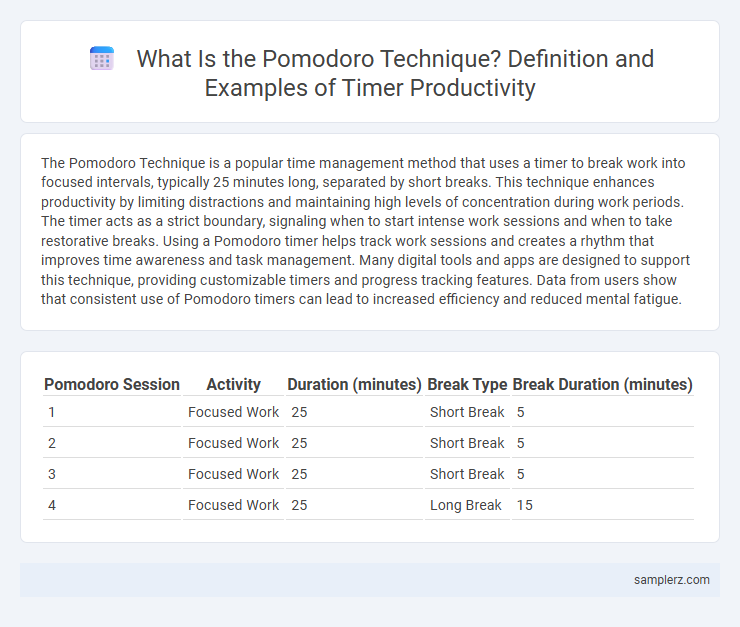The Pomodoro Technique is a popular time management method that uses a timer to break work into focused intervals, typically 25 minutes long, separated by short breaks. This technique enhances productivity by limiting distractions and maintaining high levels of concentration during work periods. The timer acts as a strict boundary, signaling when to start intense work sessions and when to take restorative breaks. Using a Pomodoro timer helps track work sessions and creates a rhythm that improves time awareness and task management. Many digital tools and apps are designed to support this technique, providing customizable timers and progress tracking features. Data from users show that consistent use of Pomodoro timers can lead to increased efficiency and reduced mental fatigue.
Table of Comparison
| Pomodoro Session | Activity | Duration (minutes) | Break Type | Break Duration (minutes) |
|---|---|---|---|---|
| 1 | Focused Work | 25 | Short Break | 5 |
| 2 | Focused Work | 25 | Short Break | 5 |
| 3 | Focused Work | 25 | Short Break | 5 |
| 4 | Focused Work | 25 | Long Break | 15 |
What is the Pomodoro Technique?
The Pomodoro Technique is a time management method developed by Francesco Cirillo in the late 1980s that uses a timer to break work into intervals, traditionally 25 minutes in length, separated by short breaks. This technique leverages focused work sessions called "Pomodoros" to enhance concentration and reduce burnout. Users increase productivity by minimizing distractions and maintaining consistent work rhythms through structured time blocks.
Key Benefits of Using a Pomodoro Timer
Using a Pomodoro timer enhances productivity by breaking work into focused intervals, typically 25 minutes, followed by short breaks that prevent burnout and maintain mental clarity. This method improves time management by creating a sense of urgency, which helps minimize distractions and sustain deep concentration on tasks. Regular use of Pomodoro timers also increases motivation and provides measurable progress, making it easier to track productivity and adjust workloads effectively.
Setting Up Your First Pomodoro Session
Set your timer to 25 minutes to begin the first Pomodoro session, creating a clear, focused work interval. Eliminate distractions by turning off notifications and organizing your workspace before the timer starts. After completing the Pomodoro, take a 5-minute break to recharge and maintain productivity throughout your workday.
Step-by-Step Example: 25-Minute Pomodoro Timer
Set a 25-minute Pomodoro timer and dedicate this focused interval to a single task, eliminating all distractions. Once the timer rings, take a 5-minute break to recharge before starting the next 25-minute session. Repeat this cycle four times, then enjoy a longer 15-30 minute break to maximize productivity and maintain sustained concentration.
Sample Pomodoro Daily Schedule
The Sample Pomodoro Daily Schedule breaks work into focused 25-minute intervals followed by 5-minute breaks, enhancing productivity through time management. After completing four Pomodoros, a longer 15-30 minute break helps maintain mental clarity and prevents burnout. This structured approach improves concentration, reduces distractions, and increases overall task efficiency.
Tools and Apps for Effective Pomodoro Timing
Effective Pomodoro timing relies on specialized tools and apps such as Focus Booster, TomatoTimer, and Be Focused, which streamline work intervals with customizable 25-minute sessions and 5-minute breaks. These apps offer features like task tracking, session analytics, and distractions blocking to enhance focus and productivity. Integration with calendars and productivity platforms further supports time management and progress monitoring throughout the workday.
Tracking Progress During Pomodoro Intervals
Tracking progress during Pomodoro intervals involves using timers that segment work into 25-minute focused bursts followed by short breaks, enhancing time management and concentration. Digital Pomodoro apps often include features to monitor completed intervals, allowing users to analyze productivity patterns and adjust work rhythms effectively. This systematic tracking supports sustained focus and helps identify peak performance times within daily workflows.
Integrating Breaks Between Pomodoro Sessions
Integrating breaks between Pomodoro sessions enhances focus by preventing mental fatigue and maintaining sustained productivity. Using a timer set for 25-minute work intervals followed by 5-minute breaks optimizes cognitive performance and reduces burnout. Longer breaks of 15 to 30 minutes after four consecutive Pomodoros support recovery and improve overall task efficiency.
Customizing Pomodoro Timers for Different Tasks
Customizing Pomodoro timers involves adjusting work intervals and break durations based on task complexity and individual focus rhythms to maximize productivity. For example, creative tasks may benefit from longer 50-minute sessions with extended breaks, while routine tasks might be suited to traditional 25-minute intervals. Incorporating personalized timer settings enhances concentration and task management efficiency by aligning with specific cognitive demands.
Tips to Maximize Focus with the Pomodoro Example
Using a Pomodoro timer, set intervals of 25 minutes of focused work followed by 5-minute breaks to enhance concentration and prevent burnout. During each Pomodoro session, eliminate distractions such as phone notifications and create a dedicated workspace to improve productivity. Tracking completed Pomodoros provides insight into work patterns, enabling adjustments for optimal focus and efficiency.

example of Pomodoro in timer Infographic
 samplerz.com
samplerz.com